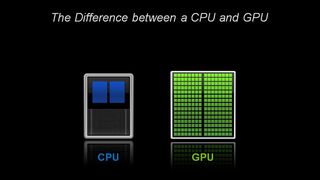WHAT’S THE DIFFERENCE BETWEEN A CPU AND A GPU?
This post is an entry inThe World Isn’t Flat, It’s Parallel series running on nTersect, focused on the GPU’s importance and the future of parallel processing. Today, GPUs can operate faster and more cost-efficiently than CPUs in a range of increasingly important sectors, such as medicine, national security, natural resources and emergency services. For more information on GPUs and their applications, keep your eyes on The World Isn’t Flat, It’s Parallel.
The CPU (central processing unit) has often been called the brains of the PC. But increasingly, that brain is being enhanced by another part of the PC – the GPU (graphics processing unit), which is its soul.

All PCs have chips that render the display images to monitors. But not all these chips are created equal. Intel’s integrated graphics controller provides basic graphics that can display only productivity applications like Microsoft PowerPoint, low-resolution video and basic games.
The GPU is in a class by itself – it goes far beyond basic graphics controller functions, and is a programmable and powerful computational device in its own right.
The GPU’s advanced capabilities were originally used primarily for 3D game rendering. But now those capabilities are being harnessed more broadly to accelerate computational workloads in areas such as financial modeling, cutting-edge scientific research and oil and gas exploration. In a recent BusinessWeek article, Insight64 principal analyst Nathan Brookwood described the unique capabilities of the GPU this way: “GPUs are optimized for taking huge batches of data and performing the same operation over and over very quickly, unlike PC microprocessors, which tend to skip all over the place.”
Architecturally, the CPU is composed of a only few cores with lots of cache memory that can handle a few software threads at a time. In contrast, a GPU is composed of hundreds of cores that can handle thousands of threads simultaneously. The ability of a GPU with 100+ cores to process thousands of threads can accelerate some software by 100x over a CPU alone. What’s more, the GPU achieves this acceleration while being more power- and cost-efficient than a CPU.
GPU-accelerated computing has now grown into a mainstream movement supported by the latest operating systems from Apple (with OpenCL) and Microsoft (using DirectCompute). The reason for the wide and mainstream acceptance is that the GPU is a computational powerhouse, and its capabilities are growing faster than those of the x86 CPU.
In today’s PC, the GPU can now take on many multimedia tasks, such as accelerating Adobe Flash video, transcoding (translating) video between different formats, image recognition, virus pattern matching and others. More and more, the really hard problems to solve are those that have an inherent parallel nature – video processing, image analysis, signal processing. The combination of a CPU with a GPU can deliver the best value of system performance, price, and power.
Source:
http://blogs.nvidia.com/
